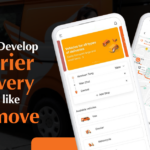Have you been noticing the time you spent on smartphones? Not only you but we all are highly invested in smartphones for personal to professional work.
You can take your gaze from your phone and look around, most of the people are hooked to their phones. A survey says, more than 90% time we use smartphones is spent on the application.
The ease of availability of the internet and increasing use of smartphones has drawn the attention of companies. The mobile market is growing by leaps and bounds.
Well, if you are thinking of developing an app, it is a great idea but what exactly goes behind developing an app? The mobile app development process is distinct from website app development.
To develop a competitive mobile app you need to have a perfect roadmap that should match mobile app development standards.
Table of Contents
Steps To Iterative Mobile App Development
1. Be specific with the goal of your app
Before jumping to mobile app development you need to be specific with your goal. You should be able to answer a few questions like, what is the purpose of developing this app? Who will be the target audience? What is my budget? Which platform I should be targeting? What should be monetizing plans? If you have a business, how will the app affect my business? Should I integrate advanced features? Well, you should know the idea is equally important to implementation. A good idea and a good roadmap make the process a lot more easier and effective.
You can either have a completely new idea that should be useful for the audience or you can think of what you can add to make the application better. Whatever your idea is to make sure it directly impacts user life and fits with mobile app development standards.
Rethink the problems your app will be able to solve. Technologies are supposed to make life simpler and easier, your app should satisfy this purpose.
2. Wireframe your vision
Now, that you have your idea suppress your temptation to just start designing. First with the help of your team wireframe your vision on paper. While using pen and paper you can pay attention to minute factors and change them wherever needed.
The more you analyze this foundation step, the better it will be. Making any changes here is quick and easy, later on, you may have to drain your pocket as well as time. A rough sketch will help you to visualize better.
3. Check your competitors
Now, you have the vision, you have the plan, next you need to know your competitor. Competitors play a key role in deciding the success of the project.
You can not only know about their services and features but also can learn from their mistakes. Your research will help you to know who are providing the same services as you are thinking of and get an idea of marketability on the profitability of your idea.
You can use the keywords to search on different platforms including Google and the Apple app store. Note the similarities and differences of all apps and see what difference your idea is going to make in users’ life.
The details are necessary to get a better insight and predict the future of the application. You need to analyze and learn from your competitors.
4. Know your target audience
Next, an important step in the mobile app development process is to identify the target audience. You might think why is it important to specify a target audience and how to do it? With this cut-throat competition around, you just cannot put your application on the app store and wish for things to work out.
Every step should be well planned and executed. It is important to know the target audience as your target audience will help you to decide the color and features needed in the app.
To develop a user-friendly app, you need to know the taste of your audience. You can check on a few metrics to decide the target audience such as age, location, gender, etc.
For example, an app developed for kids needs a vibrant color whereas one developed for senior citizens needs soft colors. Analyze your target audience thoroughly, it is a tiresome process but efforts are worth your vision.
You can search your target audience on different platforms as well as on the app store. The audience of your competitors’ app will tell a lot about the likeability.
Different mobile phones have different color saturation and screen resolution, you need a target audience to know which type of phone you are going to target.
5. Monetization of the app
Do not overlook this aspect of the app, else you might be demotivated. Well, if you are someone who says- I am not in it for money- you need to get over your excuse.
You need to have a financial target and be motivated to hit it. Some of the common ways to monetize the app are ad revenue, in-app purchase, freemium model, etc. This is not a monetization guide, so here we have mentioned it briefly.
6. Prototype is a must
Now, if you are thinking you are done with the above steps and you will send your idea to the developer for the mobile app development process– that’s it.
well, no, you need to research and know more about your project. We recommend you go for prototype development first. The prototype can be called the early development model of the app.
Interact with the developer, so that the developer can get a clear idea of what you want. The better you explain, the clearer picture your developer will have. When in confusion, your developer can run back to your prototype and organize the flow.
You must discuss in detail with developers of a mobile application development company the factors like what type of transition, the animation you are looking for.
How is the screen supposed to be arranged? You can share your design system with a developer that should include basic details like the color you want, font, spacing, opacity, alignment, and so on.
Make sure the design and development team are well aligned and there is no space for misunderstanding. The prototype will help you to get an overall idea of the app, its usage, look, and performance on a fundamental level.
7. Test your prototype on different mobile systems
After developing the prototype it’s time to go for rigorous testing. Hire dedicated developers to point out defects and areas that need improvements.
To ensure your development is compatible with different systems you need to test it. The earlier you test, the easier you can fix issues and will also reduce the cost of fixing bugs.
Changing the app UIs is not very costly so it is wise to identify bugs at this stage. Sometimes when all the coding is done, you might need to fix it after that the cost rises hugely up to 100%. You can use user testing software, for instance, Crazy Egg to check the app.
A mobile application development company goes for functional testing, which helps to check the performance of features in the app. Make sure the features are functioning well and smooth.
Next, you should check app performance testing. This will not only help to check the overall performance of the app but will also let you know how efficiently it operates on any mobile.
Check your app on all possible platforms that you thought your app will be running on. Check screen size and operating system version as well. If your app is slow make sure you fix the issue because people in this era do not have time for slow-responding applications or websites.
This annoys users. You need to ensure your app is meeting the requirements of end-users. Testing helps you to notice minor defects that might have been overlooked.
8. Improve according to feedback
Now that you have the feedback of your prototype mobile app developers for hire can go for the actual development of the application and do not forget to make changes according to the feedback.
9. Deployment
Once you are done with all these steps, you need to go through the deployment process. While planning for the development of the app, we have insisted you take a time frame for deploying the app.
App development is a long process but the timely launch is of utmost importance to make the project successful. opt for continuous deployment to minimize the downtime.
Now, when you are going to deploy the app on the app store make sure your certificates are up-to-date. Along with the developer, the certificate makes sure the features and compatibility of the app are also up-to-date.

If you are thinking of launching your app on the Google play store go through its submission and review process. You need to fill forms and submit app description and screenshots to launch your app.
Your app needs to pass through the screening process. Google uses an automated algorithm to analyze the app. Once this is done Google has a team of reviewers who will be manually testing your app. Mobile developers for hire are well with these technicalities.
But what if you want to launch on the Apple app store? Well, then the process is almost similar to launching on the Google play store. Apple manually reviews your app to verify the app. So, to synchronize you might need to make some changes here and there.
When you pass this process, congratulations your app is on the app store. Now, the mobile app development company should be ready to make changes in the app as per reviews and feedback. It is an important step to ensure the app is customer-friendly and your users are satisfied with your app.
10. Mobile app monitoring
Technology is an ever-changing field, now and then innovations are introduced. You should hire dedicated developers to keep up with the changing market demands.
Do not assume after developing the app, your work is done. No, next you need to monitor your app. Your app might need additional updates and performance improvements to make it user-friendly. Some of the important things that you need to monitor are:
- Crashes: We are living in you can quickly resolve it. cut-throat competitive world, your app needs to be highly functional. It is important to keep track of your app performance. Track your users’ actions that led to crashes so that you can quickly resolve them.
- Start and resume time: To ensure a positive user experience, you need to check the start time as well as application launch time. If the app is quick then it is more appreciated.
- Technical performance: A performance monitoring system will help you to test the speed and overall technical performance of the app. A Mobile app development company can work on parts that are less performing and optimize the app.
- Battery and cellular data consumption: If you are looking forward to having the app for the long run in users’ smartphones you need to make sure your app doesn’t drain the battery fast it will frustrate the user. Along with this you also need to check the consumption of cellular data. The user does not like to keep an app for permanent use if it eats high data. So, to manage the battery consumption, you need to think about factors that can cause faster battery drainage and work on it.
To gain customer satisfaction you need to check these factors in your iterative mobile app development project. It plays a crucial role in app reviews.
If your user is not satisfied they may add negative reviews which will decrease your ranking. Regularly monitor ratings and reviews of your app on the app store. Be judicious and think from the users’ point of view.
Wrapping It Up
Mobile app development is an arduous but profitable online venture. Here, we have mentioned the ultimate guide to developing a functional and profitable mobile app.
Hope the article helped you in solving your queries. You can follow the exact steps in your upcoming iterative mobile app development project.























